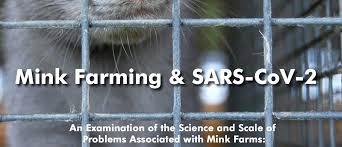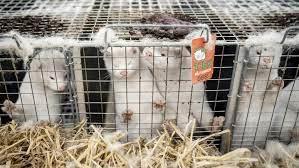 The Province of British Columbia has decided to initiate a phase-out of mink production in April 2023 with complete closure of the industry within two years. The decision was based on public health concerns and will affect nine farms in the Fraser Valley with a collective population of 320,000 mink.
The Province of British Columbia has decided to initiate a phase-out of mink production in April 2023 with complete closure of the industry within two years. The decision was based on public health concerns and will affect nine farms in the Fraser Valley with a collective population of 320,000 mink.
In contrast, Nova Scotia is allowing COVID vaccination on a restricted emergency-use basis under supervision of Veterinarians. The Province of Nova Scotia is offering funding to 24 licensed producers with twelve having received U.S. $650,000 in support, despite the fact that profitability of mink production is declining with only China serving as a market for pelts. This demand could evaporate at the snap of President Xi’s finger if wearing mink is regarded as ‘unpatriotic’.
There is considerable opposition to mink farming in Canada that has 70 licensed units. Dr. Scott Weese, a veterinarian specializing in infectious diseases, affiliated to the Ontario Veterinary College at the University of Guelph, supported the decision of health authorities in British Columbia. Dr. Weese maintains that mink that are susceptible to respiratory infections including COVID hav a high probability of developing new strains as has occurred in the EU. He clearly summarizes the situation as “we have a plausible risk and we have pretty minimal benefits apart from a small number of farmers.”
 Although the National Mink Association has raised a number of fatuous arguments to support continued mink farming, science is on the side of eliminating this public health risk. The Mink Association pointed to the fact that a number of domestic cats have been diagnosed with COVID and it is well documented that felines in zoos have contracted SARS-CoV-2 from staff. The difference between individual and mostly solitary felines and mink lies in the large number, close proximity, and concentration on a commercial farm. These are conditions that can lead to the emergence of new strains, irrespective of vaccination. There is sufficient clinical and epidemiologic evidence that vaccinated humans can be reinfected, although they do not suffer the extreme clinical effects, such as requiring hospitalization and even death compared to non- vaccinated individuals. Vaccination may well suppress clinical signs in mink housed on farms, but virus will continue to circulate with the potential of mutation and the possibility of a more virulent strain emerging. There are a lot more Greek letters after Omicron!
Although the National Mink Association has raised a number of fatuous arguments to support continued mink farming, science is on the side of eliminating this public health risk. The Mink Association pointed to the fact that a number of domestic cats have been diagnosed with COVID and it is well documented that felines in zoos have contracted SARS-CoV-2 from staff. The difference between individual and mostly solitary felines and mink lies in the large number, close proximity, and concentration on a commercial farm. These are conditions that can lead to the emergence of new strains, irrespective of vaccination. There is sufficient clinical and epidemiologic evidence that vaccinated humans can be reinfected, although they do not suffer the extreme clinical effects, such as requiring hospitalization and even death compared to non- vaccinated individuals. Vaccination may well suppress clinical signs in mink housed on farms, but virus will continue to circulate with the potential of mutation and the possibility of a more virulent strain emerging. There are a lot more Greek letters after Omicron!
Clearly the Canadian Mink Breeders’ Association is fighting a rearguard action with lower demand and falling prices for pelts. This is clearly a time to eliminate commercial multiplication of mink and eliminate a potential human health hazard since the product is essentially an unnecessary luxury with few producers involved.